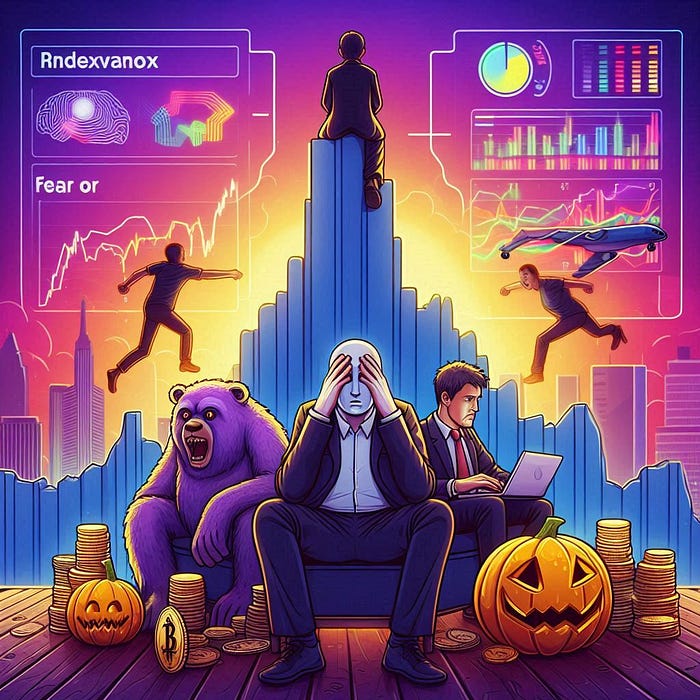In the volatile world of cryptocurrency, investor sentiment plays a pivotal role in price movements. The Greed and Fear Index is a powerful tool that helps traders understand and react to the emotions driving the market. By measuring the levels of fear and greed among investors, this index provides insights that can guide buying and selling decisions, potentially reducing risk and enhancing returns. Whether you’re a beginner or a seasoned investor, understanding the Greed and Fear Index could be your key to mastering market sentiment and making informed trading decisions.
The Greed and Fear Index is a metric designed to gauge the overall sentiment of the cryptocurrency market. It operates on a scale from 0 to 100, where 0 represents “Extreme Fear,” and 100 indicates “Extreme Greed.” By analyzing several market factors, this index captures the emotional landscape of crypto investors, helping to assess whether the market is overbought or oversold.
The Greed and Fear Index was inspired by similar indicators in traditional financial markets, like CNN’s Fear & Greed Index for the stock market. In crypto, this index has become particularly valuable due to the sector’s high volatility and susceptibility to rapid sentiment shifts.
The index draws data from several key factors to produce a score:
1. Volatility
Volatility is a core component, assessing how much the price of Bitcoin and other major cryptocurrencies fluctuates. Increased volatility often signals higher levels of fear among investors.
2. Market Momentum and Volume
Market momentum and volume evaluate buying and selling activity over a specific period. Higher buying pressure may reflect greed, while increased selling activity indicates fear.
3. Social Media Sentiment
Social media platforms like Twitter, Reddit, and Telegram are analyzed to gauge public sentiment. Positive mentions and engagement suggest greed, whereas negative discussions indicate fear.
4. Bitcoin Dominance
Bitcoin’s market share can also impact the index. When Bitcoin’s dominance rises, it may signify a conservative stance, leaning towards fear, as investors are cautious and prefer Bitcoin over altcoins.
5. Google Trends
Search volume for crypto-related terms (like “Bitcoin price drop” or “crypto crash”) on Google Trends reflects the public’s interest in or worry about the market, contributing to the index score.
6. Surveys
Some Greed and Fear indices may include survey data from crypto investors, providing an additional perspective on market sentiment.
The Greed and Fear Index offers traders an additional lens to view market sentiment, allowing them to assess emotional extremes that often drive price actions.
1. Identifying Buying Opportunities in Fear
When the index indicates “Extreme Fear,” it can mean that the market is oversold. For experienced investors, this might signal an opportunity to buy assets at lower prices.
2. Spotting Sell Signals During Greed
Conversely, when the index shows “Extreme Greed,” it may suggest the market is becoming overheated. This can be a cue to consider selling or reducing positions, as high greed levels are often followed by corrections.
3. Risk Management
Using the Greed and Fear Index in combination with technical analysis and other indicators can improve risk management. It helps avoid decisions based solely on FOMO (fear of missing out) or panic selling, fostering a more disciplined approach to investing.
While the Greed and Fear Index shouldn’t be the sole factor guiding trading decisions, it can complement other strategies:
1. Entry and Exit Points
Investors can use the index to set entry and exit points. For instance, when the index shows high fear levels, it may be a good time to consider entering the market cautiously. High greed levels could be used to evaluate potential exits or take profits.
2. Confirmation Tool
This index can also act as a confirmation tool. If technical indicators suggest a bullish trend and the index is in “Greed” territory, it may confirm the trend’s strength. Conversely, aligning “Fear” on the index with bearish indicators could confirm a potential downtrend.
3. Position Sizing
Traders can adjust position sizes based on the index reading. For example, during extreme greed, smaller positions might mitigate risk, while larger positions, during fear, could capitalize on lower prices.
While the Greed and Fear Index is valuable, it has its limitations:
- Short-Term Focus
The index is typically useful for short- to medium-term market movements but may not always provide accurate signals for long-term investments. - High Volatility
Cryptocurrency markets can shift rapidly, and the index may not always capture sentiment changes in real-time. - Not a Standalone Tool
Relying solely on the Greed and Fear Index without other indicators can lead to poor trading decisions, as it only measures sentiment and not fundamental market conditions.
Conclusion
The Greed and Fear Index is an invaluable tool for understanding market sentiment and emotional drivers in the cryptocurrency world. By identifying moments of extreme fear and greed, investors can better gauge market psychology and make more informed trading decisions. While it should not replace other analytical tools, the Greed and Fear Index adds depth to an investor’s toolkit, especially in such a sentiment-driven market.
Takeaways
- The Greed and Fear Index measures market sentiment, ranging from extreme fear to extreme greed.
- It uses factors like volatility, market momentum, social media sentiment, and Bitcoin dominance.
- Extreme fear often indicates potential buying opportunities, while extreme greed can signal the need for caution.
- It is best used with other technical and fundamental analysis tools for effective risk management.
Follow us to stay updated.
Read Our Guides and Tips on Investing
Disclaimer: This content is for informational purposes only and not financial advice.
Your One-Stop Crypto Hub
Please be advised that clicking the link will take you offsite, outside of Medium.

